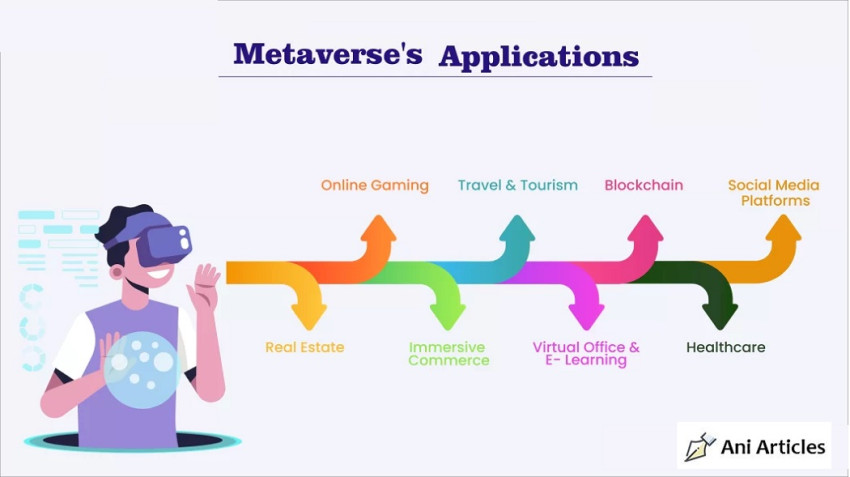
Introduction
The metaverse, a vast digital universe where people can interact, explore, and create, holds immense potential across various domains. This article explores the applications of the metaverse in entertainment, education, commerce, and social interaction. We will delve into the transformative power of the metaverse in each of these areas, examining how it revolutionizes experiences and enhances human interaction in unprecedented ways. BitsourceiT Provides Metaverse Creation Services for each kind of environment of your business.
Entertainment
1.1 Virtual Reality Gaming
One of the most prominent applications of the metaverse in entertainment is virtual reality (VR) gaming. The metaverse provides a platform for immersive and interactive gaming experiences, where users can step into virtual worlds and engage with rich and dynamic gameplay. VR headsets and motion controllers enable users to physically interact with the virtual environment, enhancing the sense of presence and immersion.
In the metaverse, gamers can collaborate with friends or compete against players from around the world in multiplayer experiences. Virtual reality enables new levels of realism, making players feel like they are inside the game, whether exploring fantastical realms, solving puzzles, or engaging in adrenaline-pumping action sequences. The metaverse expands the possibilities of gaming, allowing for endless creativity and innovation in game design.
1.2 Immersive Storytelling and Cinematic Experiences
The metaverse transforms storytelling by offering immersive and interactive narrative experiences. Users can become active participants in virtual stories, influencing the plot and outcome. They can explore richly detailed virtual environments, interact with characters, and make choices that shape the storyline.
Cinematic experiences in the metaverse take storytelling to new heights, blurring the line between movies and interactive experiences. Users can watch films in virtual theaters, attend virtual premieres, and even step into the story as virtual characters, experiencing the narrative from within. This merging of cinema and virtual reality enhances the emotional connection between the audience and the story, creating deeply engaging and memorable experiences.
1.3 Virtual Concerts and Live Events
The metaverse has revolutionized the live entertainment industry, allowing for virtual concerts and events that transcend physical limitations. Artists and performers can reach a global audience without the need for physical venues, expanding their reach and providing unique and immersive experiences to fans.
Virtual concerts in the metaverse create interactive and visually stunning environments where users can attend live performances, interact with the artists, and even customize their viewing experience. The metaverse also enables virtual festivals, conferences, and other live events, fostering global connectivity and eliminating geographical constraints. Users can engage with others, network, and participate in discussions, creating a sense of community and shared experiences.
1.4 Virtual Theme Parks and Attractions
In the metaverse, virtual theme parks and attractions offer exciting and immersive experiences that rival their physical counterparts. Users can explore virtual replicas of famous landmarks, historical sites, or entirely fictional worlds. They can enjoy virtual rides, thrilling experiences, and interactive exhibits.
Virtual theme parks in the metaverse go beyond traditional entertainment, incorporating gamification elements, storytelling, and social interaction. Users can embark on quests, solve puzzles, and compete in challenges within the virtual park. This blending of entertainment and gamified experiences creates a new dimension of enjoyment and engagement.
1.5 Sports and Esports in the Metaverse
The metaverse transforms the world of sports and esports, offering unique opportunities for fan engagement, virtual competitions, and enhanced viewing experiences. Users can spectate live sports events from within the metaverse, experiencing the excitement of the game as if they were in the stadium.
Esports in the metaverse thrive as users compete in virtual tournaments and leagues. The metaverse provides a platform for professional gamers and esports enthusiasts to showcase their skills, connect with fans, and create engaging content. Virtual stadiums and arenas within the metaverse create an immersive atmosphere for esports events, where users can cheer for their favorite teams and interact with fellow fans.
Education
2.1 Virtual Classrooms and Learning Experiences
The metaverse has the potential to revolutionize education by providing virtual classrooms and learning experiences that enhance engagement and accessibility. Virtual classrooms enable students and teachers from around the world to connect and collaborate in immersive environments. Through avatars, students can interact with each other, participate in discussions, and engage in collaborative projects.
In the metaverse, learning experiences can be gamified, incorporating interactive elements, simulations, and virtual field trips. Students can explore historical sites, dive into scientific simulations, or embark on virtual adventures that deepen their understanding of various subjects. The metaverse also facilitates personalized learning, allowing students to progress at their own pace and explore topics of interest in depth.
2.2 Simulations and Training
Simulations in the metaverse offer realistic training experiences across a wide range of fields, from healthcare and aviation to emergency response and engineering. Virtual simulations provide a safe and controlled environment for learners to practice skills, make decisions, and experience real-life scenarios.
For example, medical students can perform virtual surgeries, pilots can simulate flight scenarios, and firefighters can practice emergency response procedures. The metaverse allows for repetition, feedback, and interactive learning, enabling learners to refine their skills and knowledge in a risk-free environment.
2.3 Global Collaboration and Cultural Exchange
The metaverse fosters global collaboration and cultural exchange among students and educators. Through virtual classrooms and collaborative platforms, individuals from different parts of the world can connect, share ideas, and work together on projects.
The metaverse breaks down geographical barriers, providing opportunities for students to learn from diverse perspectives and cultures. Virtual cultural exchanges allow students to explore different traditions, languages, and customs, fostering empathy, understanding, and global citizenship.
2.4 Accessible Education for All
One of the significant advantages of the metaverse in education is its potential to provide accessible education for all. Virtual learning environments accommodate individuals with physical disabilities or mobility limitations, ensuring that they can participate fully in educational activities. The metaverse eliminates the barriers posed by physical infrastructure and offers inclusive learning experiences.
Furthermore, the metaverse enables remote and distance learning, ensuring that education is accessible to individuals in remote or underserved areas. With internet access and basic technology, learners can connect to the metaverse and access quality educational resources and experiences.
2.5 Lifelong Learning and Skill Development
The metaverse supports lifelong learning and skill development by providing a platform for individuals to acquire new knowledge, explore hobbies, and develop professional skills. Users can engage in virtual workshops, attend lectures by experts, and access a vast repository of educational content.
The metaverse also facilitates upskilling and reskilling opportunities by offering interactive courses and certifications. Users can acquire new skills relevant to their careers or pursue personal interests. Lifelong learning becomes dynamic and engaging within the metaverse, empowering individuals to adapt to the evolving demands of the digital age.
Commerce
3.1 Virtual Marketplaces and Digital Assets
The metaverse transforms commerce by creating virtual marketplaces where users can buy, sell, and trade digital assets. Digital art, virtual real estate, in-game items, and other digital collectibles can be bought and sold within the metaverse, opening up new avenues for creators, collectors, and investors.
Virtual marketplaces leverage blockchain technology to ensure authenticity, provenance, and security of digital assets. Non-fungible tokens (NFTs) enable unique ownership of digital items, granting value and scarcity to virtual creations. The metaverse creates a vibrant economy around digital assets, fueling creativity and entrepreneurship.
3.2 E-Commerce in the Metaverse
E-commerce in the metaverse transcends traditional online shopping experiences by providing immersive and interactive environments for customers. Virtual storefronts and showrooms allow users to browse and purchase products in a visually engaging manner.
Virtual try-on technologies enable users to digitally try on clothing, accessories, or cosmetics, enhancing the online shopping experience. Users can customize avatars to reflect their own body measurements, allowing for accurate virtual fittings and personalized recommendations.
3.2 E-Commerce in the Metaverse
augmented reality (AR) technologies, allowing users to visualize how products would look in their real-world environments. For example, furniture retailers can offer virtual AR experiences where users can place virtual furniture items in their homes to see how they fit and look before making a purchase.
Social commerce also thrives in the metaverse, as users can engage with friends and influencers while shopping. They can seek recommendations, share their virtual shopping experiences, and make group purchases, creating a social and interactive shopping environment.
3.3 Virtual Try-Ons and Personalized Shopping
The metaverse revolutionizes the try-on experience by offering virtual fitting rooms and personalized shopping recommendations. Users can create virtual avatars that resemble their physical appearance and try on virtual clothing, accessories, and cosmetics. This allows for accurate size and style exploration without the need for physical garments.
Virtual try-ons not only enhance convenience but also reduce the environmental impact of excessive returns. Users can make more informed purchasing decisions, reducing the need for shipping and packaging associated with traditional online shopping.
Additionally, the metaverse utilizes AI algorithms and user data to provide personalized shopping recommendations. By analyzing users' preferences, browsing history, and behavior, the metaverse can offer tailored product suggestions, enhancing the overall shopping experience.
3.4 Social Commerce and Influencer Marketing
In the metaverse, social commerce merges seamlessly with e-commerce, creating a dynamic space for influencer marketing and brand engagement. Influencers and content creators can establish virtual personas and engage with their audiences in interactive ways.
Virtual spaces within the metaverse can host virtual meet-and-greets, live product demonstrations, and Q&A sessions with influencers. Users can directly interact with influencers, ask questions, and receive personalized recommendations. Influencers can also showcase sponsored products within virtual environments, allowing users to engage with and purchase featured items.
Social commerce in the metaverse leverages the power of community and user-generated content. Users can share their virtual shopping experiences, post reviews, and recommend products to their peers, fostering a sense of trust and authenticity within the metaverse community.
3.5 Blockchain and Secure Transactions
Blockchain technology plays a vital role in the metaverse's commerce ecosystem, ensuring secure and transparent transactions. Blockchain enables verifiable ownership and provenance of digital assets, eliminating the risk of counterfeit or unauthorized duplication.
Smart contracts built on blockchain networks enable secure and automated transactions within the metaverse. Users can engage in peer-to-peer transactions, exchange digital assets, and create decentralized marketplaces. The metaverse's reliance on blockchain technology ensures trust and integrity in commerce interactions.
Additionally, cryptocurrencies and digital tokens serve as native currencies within the metaverse, facilitating seamless and secure transactions. Users can utilize cryptocurrencies for purchases, tipping content creators, and participating in virtual economies. Blockchain-based systems enable traceability and accountability, enhancing the overall commerce experience in the metaverse.
Social Interaction
4.1 Virtual Communities and Social Networking
The metaverse fosters the creation of virtual communities and social networks, where users can connect, interact, and build relationships. Virtual worlds provide platforms for users to gather, explore, and engage in various activities together.
Within virtual communities, users can customize their avatars to reflect their identities and preferences. They can participate in shared experiences, attend virtual events, or engage in collaborative projects. The metaverse transcends geographical boundaries, allowing individuals from different parts of the world to connect and form social bonds.
Social networking in the metaverse goes beyond traditional platforms, as users can engage with others in immersive and interactive ways. Users can communicate through voice chat, text messaging, and real-time interactions. Virtual spaces within the metaverse become meeting points for socializing, fostering a sense of belonging and community.
4.2 Digital Identities and Avatars
In the metaverse, users can create and customize digital identities and avatars that represent their virtual personas. Avatars serve as extensions of users' personalities and allow for self-expression in virtual environments.
Through avatars, users can present themselves in different ways, exploring various aspects of their identities. Avatars can be customized in terms of appearance, clothing, accessories, and even abilities. This level of customization enhances user agency and empowers individuals to shape their virtual presence.
Digital identities within the metaverse can also offer anonymity or pseudonymity, providing users with the freedom to express themselves without the constraints of their physical identities. This opens up possibilities for self-discovery, experimentation, and the exploration of diverse perspectives.
4.3 Real-Time Communication and Collaboration
Real-time communication and collaboration are integral to the social interaction within the metaverse. Users can engage in voice or video calls, text chat, or group discussions, fostering seamless and interactive communication.
Virtual environments within the metaverse support real-time collaboration, allowing users to work together on projects, share ideas, and brainstorm. Whether for professional collaboration or social activities, the metaverse facilitates dynamic and engaging interactions.
Virtual meeting spaces within the metaverse offer immersive alternatives to traditional video conferencing, providing realistic avatars and customizable environments. Users can conduct virtual meetings, attend virtual conferences, or host virtual gatherings, bridging the gap between physical and digital interactions.
4.4 Virtual Gatherings and Events
The metaverse redefines the concept of gatherings and events by providing virtual spaces for people to come together. Users can attend virtual parties, celebrations, and social events within the metaverse, offering unique and engaging experiences.
Virtual gatherings and events within the metaverse offer interactive elements such as live performances, interactive exhibits, and engaging activities. Users can explore virtual venues, participate in shared experiences, and connect with others in dynamic ways.
These virtual events provide opportunities for individuals to socialize, network, and connect with like-minded people from diverse backgrounds. The metaverse transcends physical limitations, allowing for global connectivity and fostering a sense of community and shared experiences.
4.5 Support Groups and Mental Health Services
The metaverse can serve as a valuable platform for support groups and mental health services. Virtual environments provide a safe and inclusive space for individuals to seek support, share experiences, and connect with others facing similar challenges.
Support groups within the metaverse can address various topics such as mental health, addiction recovery, or chronic illness. Users can engage in discussions, attend virtual therapy sessions, and access resources and information that promote well-being.
Virtual therapy services leverage the metaverse's immersive nature to create therapeutic environments. Users can engage in virtual therapy sessions with licensed professionals, providing a convenient and accessible alternative to traditional in-person therapy.
Conclusion
The metaverse's applications in entertainment, education, commerce, and social interaction redefine how we experience and engage with these domains. In entertainment, the metaverse offers immersive gaming experiences, interactive storytelling, virtual concerts, and virtual theme parks. Education in the metaverse incorporates virtual classrooms, simulations, global collaboration, and accessible learning for all. Commerce in the metaverse enables virtual marketplaces, personalized shopping experiences, social commerce, and secure transactions through blockchain technology. Social interaction within the metaverse facilitates virtual communities, digital identities, real-time communication, virtual gatherings, and support groups. Create Metaverse Environments of your business by Metaverse Creation Services.
As the metaverse continues to evolve and grow, it presents new opportunities and challenges. Collaboration among stakeholders, including technologists, content creators, policymakers, and users, is crucial in shaping the metaverse's future and ensuring responsible and inclusive development. By harnessing the metaverse's potential, we can create a digital landscape where entertainment, education, commerce, and social interaction converge, enriching our lives and transforming the way we connect.






